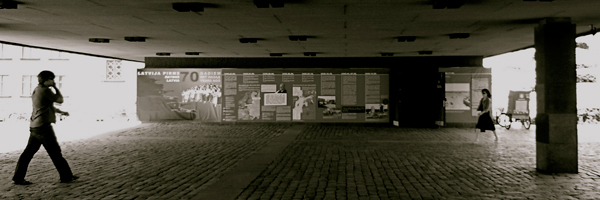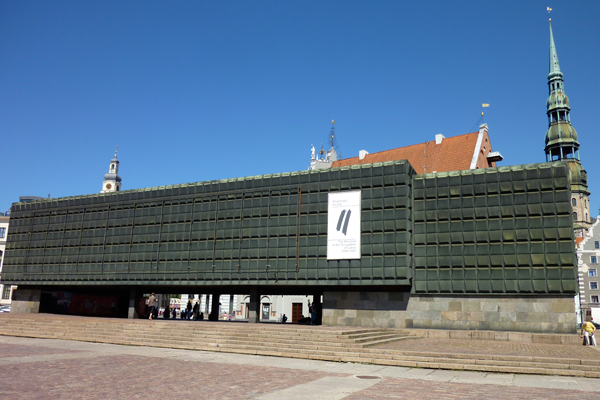The building has a fun shape: it is a rectangle with a raised floor and a ground floor that serves as a passage. Pedestrians can move freely, some stop and read the interpretive signs, others go without warning. Footsteps echo remembering this dark period.

The museum entrance is free, only donations are accepted. Can we speak of collective memory? The story is there, unrolled on our eyes, the suffering of Latvians are displayed: the exhibition traces the fifty-year occupation of Latvia.
According to the chronology, I wander in the different spaces: the first Soviet occupation from 1940 to 1941 after the Molotov Ribbentrop Pact dividing Europe between the Soviets and the Nazis. Then, they reverse their position, broke the pact and invaded Latvia in order to eradicate communism and Jews. The Nazis themselves up as the "saviors" of Latvians against Communist rule. Appalling. After the war ended in 1945, the Soviets occupied the country again until 1991 when Latvia became independent.
The exhibition features historical documents, photographs and material evidence of crimes committed by both totalitarian regimes against the Latvian state and people. More than 500,000 people have been murdered, killed in action, sentenced, deported or went missing during this bloody period. The remains of the past, as in every museum of modern history, carry the sentiments and remind us of free Europe where we live.
To give a tangible and relevant dimension of these years, the museum has reproduced a Gulag barracks where prisoners were confined in inhuman conditions. The musuem was quite empty when I was there but I imagine kids coming to school and remembering what they were told by their grandparents.
Finally, some interesting parts highlight actions of Latvian resistance factions who have worked for the liberation of their country. Unpublished documents and stories mostly unknown to me, young West European who has studied the Soviet occupation in general and not on a case by case basis. Flyers misprinted, shares of resistance, pictures, all remember the museum of Resistance in Paris.
Approximately 100,000 people visit the museum each year, including two thirds of foreigners. The State Diplomatic Protocol arranges visits for politicians and diplomats in order to teach them a tragic time of their history.


The museum entrance is free, only donations are accepted. Can we speak of collective memory? The story is there, unrolled on our eyes, the suffering of Latvians are displayed: the exhibition traces the fifty-year occupation of Latvia.
According to the chronology, I wander in the different spaces: the first Soviet occupation from 1940 to 1941 after the Molotov Ribbentrop Pact dividing Europe between the Soviets and the Nazis. Then, they reverse their position, broke the pact and invaded Latvia in order to eradicate communism and Jews. The Nazis themselves up as the "saviors" of Latvians against Communist rule. Appalling. After the war ended in 1945, the Soviets occupied the country again until 1991 when Latvia became independent.
The exhibition features historical documents, photographs and material evidence of crimes committed by both totalitarian regimes against the Latvian state and people. More than 500,000 people have been murdered, killed in action, sentenced, deported or went missing during this bloody period. The remains of the past, as in every museum of modern history, carry the sentiments and remind us of free Europe where we live.
To give a tangible and relevant dimension of these years, the museum has reproduced a Gulag barracks where prisoners were confined in inhuman conditions. The musuem was quite empty when I was there but I imagine kids coming to school and remembering what they were told by their grandparents.
Finally, some interesting parts highlight actions of Latvian resistance factions who have worked for the liberation of their country. Unpublished documents and stories mostly unknown to me, young West European who has studied the Soviet occupation in general and not on a case by case basis. Flyers misprinted, shares of resistance, pictures, all remember the museum of Resistance in Paris.
Approximately 100,000 people visit the museum each year, including two thirds of foreigners. The State Diplomatic Protocol arranges visits for politicians and diplomats in order to teach them a tragic time of their history.









